Trip Report – 25-27 March 2016 : North Wairarapa
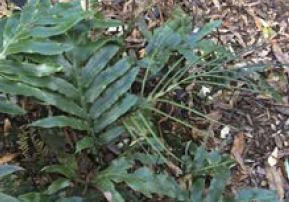 |
Blechnum colensoi.
Photo: Jeremy Rolfe. |
25.3.16: Kowhainui QEII Trust Open Space Covenant, Mauriceville, Wairarapa
NZTopo50-BN35 Alfredton
We thank Priscilla and John Paulik for permission to botanise their 2ha covenant. In a tributary of the Kopuaranga River, the forest is a remnant of ‘90-Mile Bush’, a once-vast area of native forest covering northern Wairarapa and southern Hawke’s Bay, most of which was cleared for farming in the 1800s.
The Pauliks turned off the electric fence so that we could descend into the gully. Once in there, we were first impressed by the abundance of Blechnum colensoi / waterfall fern / peretao, some with fish-skeleton-like fertile fronds.
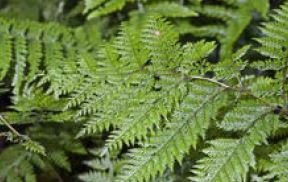 |
Leptolepia novae-zelandiae.
Photo: Jeremy Rolfe. |
We saw numerous tawa seedlings, but few saplings or young trees of the canopy species, probably because the covenant fence is not designed to exclude goats. Our party saw four goats in the bush. We have suggested to the Pauliks that they ask the QEII National Trust and Greater Wellington Regional Council about the possibility of building a fence to exclude goats and their kids from this ecological and heritage treasure. Later, up on the true left, we found a big Nestegis cunninghamii / black maire, and a massive, female kahikatea, in fruit. We admired Hoheria sexstylosa in full bloom, and about 41 fern species. These included Botrychium biforme, Diplazium australe, Leptolepia novae-zelandiae and Tmesipteris elongata.
Chris Horne
26.3.16: Mount Bruce Forest (Tararua Forest Park)
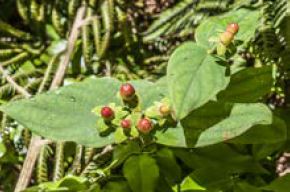 |
Hypericum androsaemum.
Photo: Jeremy Rolfe. |
NZTopo50-BN34 Shannon, DOC Conservation Unit Number T25037
From the end of Mount Munro Rd, Mauriceville, we used the at first unmarked legal access across farmland, then climbed a farm track over pasture to the forest boundary. The fence should be designed to exclude stock and feral goats, but it is not. Numerous pest-control lines cross the track, part of the impressive efforts to control pest animals in Pukaha / Mount Bruce forest, and we saw a Timms trap, ingeniously boxed to exclude kiwi. Weed species require control also. We saw tutsan / Hypericum androsaemum, elderberry / Sambucus nigra, barberry / Berberis glaucocarpa, and Himalaya honeysuckle / Leycesteria formosa, and near the farm land, old man’s beard and ragwort.
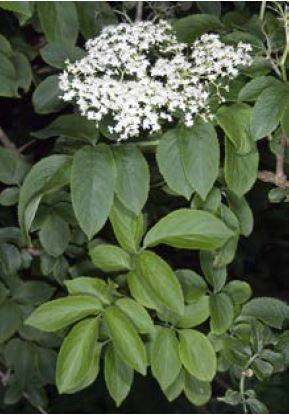 |
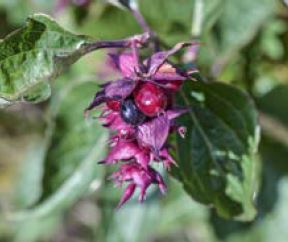 |
Sambucus nigra (top),
Leycesteria formosa.
Photo: Jeremy Rolfe. |
We used as templates, copies of the lists prepared during our field trip on the west side of Mount Bruce on 30.11.2013. Botanical highlights included five podocarps kahikatea, rimu, totara, miro and matai, Alseuosmia pusilla, Coprosma rigida, and the filmy ferns Hymenophyllum demissum, H. flabellatum, H. revolutum and H. sanguinolentum. Seedlings of rewarewa, tawa and titoki are common, suggesting that rodent control is effective. This must be maintained to ensure the eventual replacement of the understorey, canopy and emergent tiers, missing as result of many decades of seedpredation by rodents. Finally, a skink, merely 40mm long, slithered off someone’s palm, into the track-side vegetation.
Chris Horne
27.3.16: Rewanui Forest Park
NZTopo50-BP35 Bideford.
Four of us met Pat Enright at Rewanui c. 23 km east of Masterton. Native lowland forest, which makes up about half the 334ha property, is fenced from the remaining grassland and exotic trees. Unlike areas we had visited the previous two days, this forest has been well-trapped and fenced. Hence there is a good understorey, and plenty of possum fodder such as Schefflera digitata / pate.
The Montfort Trimble Foundation, which administers Rewanui, was set up by an Act of Parliament to perpetuate the wishes expressed in the will of Dr Montfort Trimble of Masterton. Dr Trimble died in 1940 and left money to promote public afforestation. Most of the trustees are appointed by Masterton District Council.
Initially they purchased 127 ha 18 km north of Masterton, on the east side of SH2. They planted much of this with Pinus radiata in 1950, and a second crop in the late 1970s. Rewanui Forest Park was purchased by the foundation in 2004, using money from the sale of these trees. The foundation is developing Rewanui as a forest park, and as a trial site for native and exotic timber trees. Besides the area of native forest, they have small stands of eleven species including kauri, red beech, silver beech and puriri.
We spent 3.5 hours botanising the low level Totara Loop track. There are some very good examples of totara, with plenty of rewarewa and matai. More exciting was the tiny Myosotis spathulata that Pat pointed out, and Fuchsia perscandens which is common on the lower track, but uncommon in Wairarapa. We added Corynocarpus laevigatus, Hymenophyllum sanguinolentum and Metrosideros perforata to the substantial plant list of the forest area.
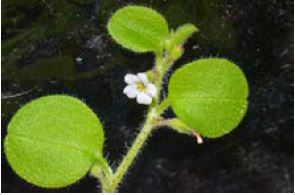 |
Myosotis spathulata.
Photo: Pat Enright. |
We could have added several species on the access track which appear to be planted, but don’t really belong in this area, e.g., Pittosporum tenuifolium.
Rodney Lewington.
Participants : Sam Buckley, Gavin Dench, Pat Enright, Chris Hopkins, Maya Hunt, Rodney Lewington, Pat McLean, Barbara Mitcalfe, Leon Perrie, Nick Saville, Darea Sherratt, co-leaders: Sunita Singh & Chris Horne.

 Site Index
Site Index







 Site Index
Site Index





